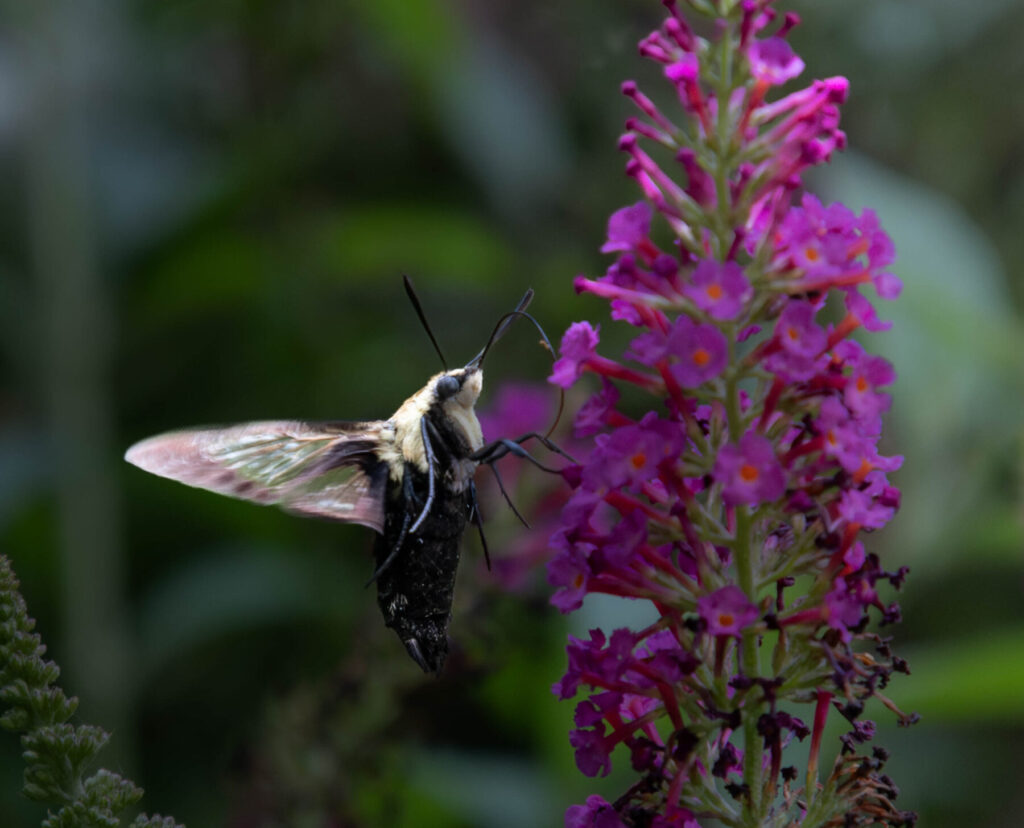Hummingbird moths have been seen as a lucky omen. In particular, a swarm of the moths was seen flying across the English Channel on D-Day, the day of the Normandy landings in the Second World War.

Spiritually, the hummingbird moth is seen by some cultures as a symbol of peace, prosperity, longevity, and good fortune.
One of the most enjoyable insect visitors to your garden is the hummingbird moth. They fly and move just like hummingbirds. They can remain suspended in the air in front of a flower while they unfurl their long tongues and insert them in flowers to sip their nectar. They even emit an audible hum like hummingbirds. Quite often inexperienced garden visitors notice what they think is a tiny hummingbird fleeting among flowers such as bee balm (Monarda). They listen incredulously when one explains to them that what they just saw was not a bird but a moth.
Hummingbird moths are plump; the tip of their tail opens into a fan. They are usually of a rich reddish-brown color, at least in part. Like all Lepidoptera their wings are covered by scales; some species lose many of the scales from patches on their wings, so they are called clearwing hummingbird moths. Like most moths they have an exceptionally long tongue which they carry rolled under their chins and that they use to reach the nectar of long-necked flowers. Such nectar is inaccessible to many other flower visitors, so these flowers prefer long tongued pollinators and try to keep the others away.
There are four species of hummingbird moths in North America. The most familiar ones are the Snowberry Clearwing (Hemaris diffinis) and the Hummingbird Clearwing (Hemaris thysbe). They are both widespread throughout North America, with the former being more abundant in the west and the latter in the east. Like most moths and butterflies, the adult hummingbird moths feed on nectar from a variety of flowers, but their larvae need more specific food plants, such as several species of honeysuckle, dogbane, or some members of the rose family such as hawthorn, cherries, and plums.
Beating their wings up to seventy beats per second and consuming nectar all day, it is no shock that the Hummingbird Moth is commonly mistaken for being a part of the avian group, Hummingbirds. Unlike most moths, which are nocturnal, Hummingbird Moths only feed upon nectar-rich plants during the day, giving meaning to their assigned genus, Hemaris, which comes from the Greek word hemera (ημερα), meaning day. While the reasoning for their common name is a little more obvious, the evolutionary advantages are remarkably interesting!
Hummingbird moths, also known as sphinx moths, undergo a complete metamorphosis, passing through egg, larval (caterpillar), pupal, and adult stages. Hummingbird moths have a short lifespan, typically ranging from 3 weeks to 7 months.
They are effective pollinators, and their presence can contribute to a healthy and vibrant ecosystem. While their larvae, hornworms, can cause some damage to plants, it is usually not significant enough to warrant concern.
Enjoy these amazing creatures.
The author of this article, Phillip Prichard, is a Paulding UGA Extension Master Gardener, Birds Georgia – Master Birder, and a UGA Master Naturalist, trained to provide education for homeowners on horticulture, sustainable landscaping, and environmentally friendly gardening practices using unbiased, research-based information from the University of Georgia. For more information, contact Paulding County UGA Extension at 770-443-7616 or view our online resources at www.ugaextension.org/paulding.